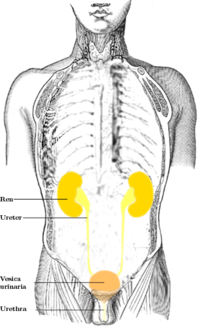
Photo from wikipedia
Importance Degeneration of neuromuscular junctions and axons is considered an important aspect of the pathomechanism of amyotrophic lateral sclerosis (ALS). However, a mechanism including the role of transactive response DNA-binding… Click to show full abstract
Importance Degeneration of neuromuscular junctions and axons is considered an important aspect of the pathomechanism of amyotrophic lateral sclerosis (ALS). However, a mechanism including the role of transactive response DNA-binding protein 43 (TDP-43) in axons has not been pathologically clarified. Objective To identify and characterize the histopathology of peripheral axons in the skeletal muscle of patients with ALS. Design, Setting, and Participants This study comprised 2 parts: a postmortem case-control study and a retrospective population-based cohort study with a minimum of 1 year of follow-up. Patients in the cohort study were enrolled from January 1, 2004, to September 30, 2019. The postmortem study included patients with sporadic ALS (SALS) with TDP-43 pathology and control patients with non-ALS disease. The cohort study enrolled patients without a family history of ALS or other neuromuscular disease and those not diagnosed with a muscle disease at biopsy. Patients were excluded if their clinical records were not screened after biopsy, if they were diagnosed with a muscular disease, and if they were harboring known causative genes of ALS. Data were collected between September 2019 and June 2021 and analyzed in June 2021. Exposures Muscle biopsy or postmortem muscle tissue examination. Main Outcomes and Measures Clinical information and muscle pathological characteristics. Results A total of 10 patients with autopsy-confirmed SALS (mean [SD] age at death, 76.1 [8.5] years; 8 men [80%]) exhibited axonal phosphorylated TDP-43 (pTDP-43)-positive accumulations in intramuscular nerve bundles; the 12 control patients without ALS did not. Among the 114 patients in the cohort study (mean [SD] age, 62.3 [16.1] years; 76 men [67%]), 71 patients (62.3%) exhibited intramuscular nerve bundles; 43 (37.7%) did not. Among those who exhibited pTDP-43-positive intramuscular nerve bundles, 33 patients (22 men [66.7%]; mean [SD] age, 65.2 [15.6] years) were later diagnosed with ALS. The other 38 patients (26 men [68.4%]; mean [SD] age, 59.3 [18.0] years) showed no pTDP-43-positive bundles and did not develop ALS. Among those without evident nerve bundles (28 men [65.1%]; mean [SD] age, 61.3 [15.3] years), 3 were later diagnosed with ALS. Among patients with ALS in the biopsy cohort, 9 with pTDP-43-positive bundles showed only lower motor neuron symptoms at biopsy. Conclusions and Relevance Results of this dual case-control and retrospective cohort study suggest that axonal pTDP-43 accumulations may be characteristic for patients with ALS. As such findings precede clinical fulfillment of the Gold Coast criteria, TDP-43 in nerve bundles may be a novel diagnostic biomarker for ALS.
Journal Title: JAMA neurology
Year Published: 2022
Link to full text (if available)
Share on Social Media: Sign Up to like & get
recommendations!